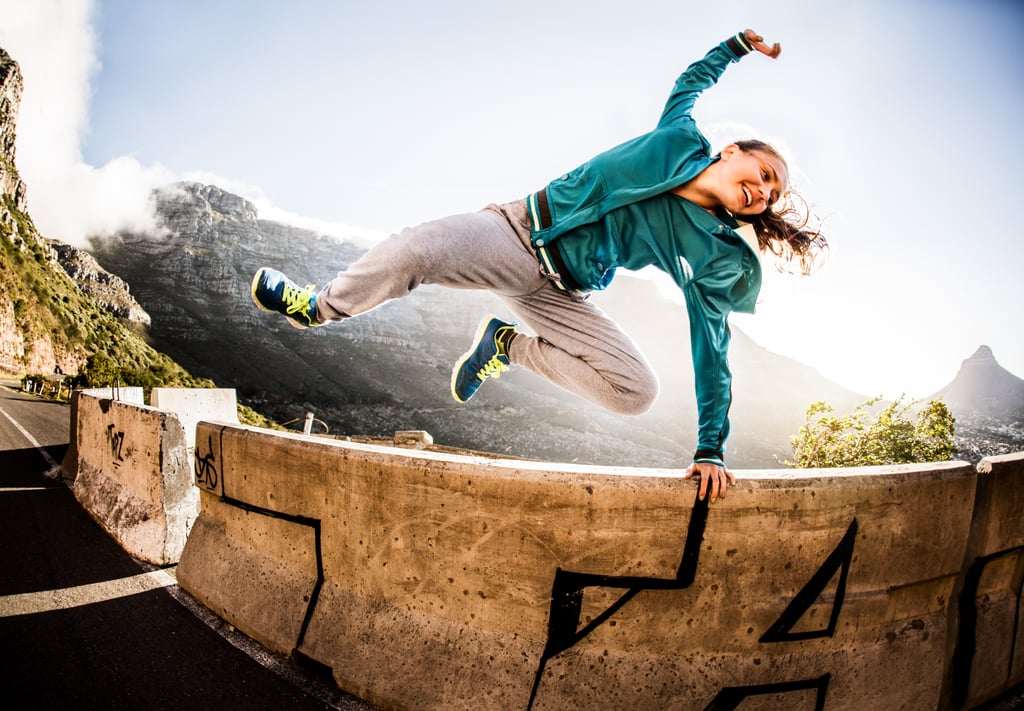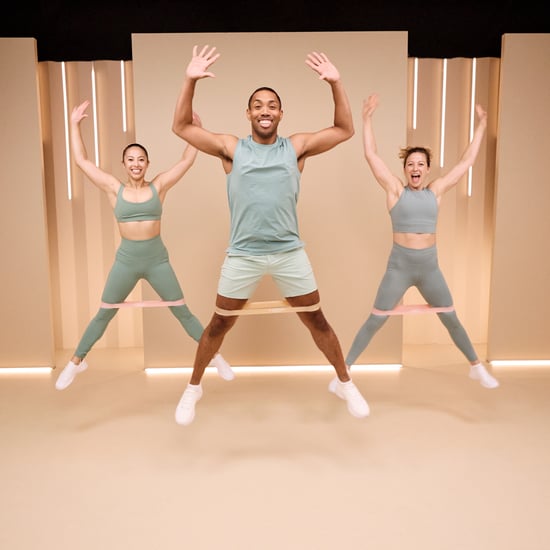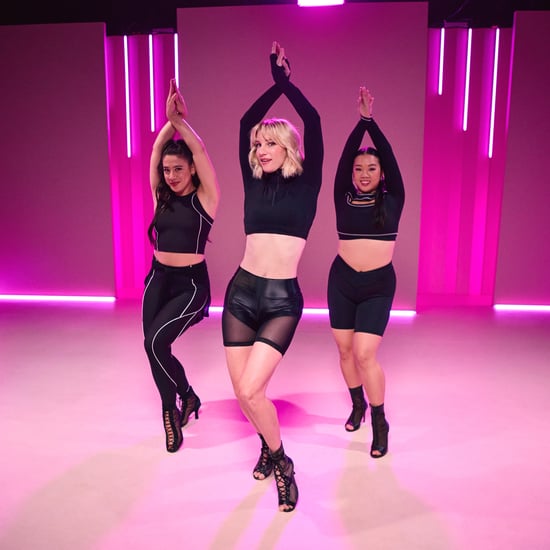What Is Parkour?
"I Don't Ever Approach Something That Scares Me": Parkour Athletes Break Down the Sport

Parkour is not the same thing as traditional gymnastics, even if it incorporates flips and tricks — after speaking with two athletes from the sport, that much is clear. There are no leotards and perfect 10.00s. Instead, there's a whole street culture behind it, and you'll see people using buildings, railings, any type of obstacle in their environment to move, ebb, and flow like they're as swift as a breeze. POPSUGAR tapped Michael "Frosti" Zernow, former pro parkour athlete for the better part of two decades and founding member of the United States Parkour Association (USPK), and Jesse La Flair, pro parkour athlete and stuntman, for more about this incredible sport.
What Is Parkour?
Michael told POPSUGAR, "About 20 years ago in France, that word parkour was born from a bunch of young people who got together and sort of reclaimed this idea of being able to move through your environment the same way people did in the jungles in the past, and running through the woods, but in an urban environment." Parkour comes from the French word parcours, meaning "the way through." The "k" was substituted in, and like martial arts, Michael said, it's a training discipline.
David Belle is credited as the inventor of parkour, which you can read about more on the World Freerunning Parkour Federation (WFPF) website. His father was a fireman and veteran who shared with him practices of French military training that are the root of what parkour is today. A man by the name of Sébastien Foucan, David's friend, is the most well-known person to bring it overseas and is considered the "father of freerunning," according to Michael.
Parkour is about challenging yourself and pushing yourself to get better, Michael said. "It really connects with people trying to find their best version of themselves. Even though it's an individual sport, I think it's definitely a group activity built through a great community." Jesse echoed that, saying that parkour is about community, but it's also about progressing your skill level. "So much of what we do is learning how to fall and be comfortable coming out of situations," he said. "I don't ever approach something that scares me. And that is why you see people capable of doing some absolutely absurd, incredible things in our sport because they've practiced and understand what to do when it goes wrong."
The reason athletes gravitate toward the sport is because doing these tricks is relatable, Jesse said — it's almost reminiscent of playing on a playground as a kid. He also pointed out that the conversation around the sport has grown so much due to social media, movies like Casino Royale (where you see Sébastien himself actually do parkour as the character Mollaka), and shows such as America Ninja Warrior.
Parkour vs. Freerunning
Parkour and freerunning are often used interchangeably in the media. Parkour is more about moving from point A to point B in the fastest, most efficient way possible, whereas freerunning is adding those tricks and personal flair you've probably seen on YouTube. "Parkour is really the birthplace of all of those things," Michael explained. "Same way skateboarding used to be riding from one place to another, and then it became hanging out in spots trying to see what you could do, freerunning is an exploration, an expansion of what parkour was. It uses some of the same movements, mentalities, and training disciplines but adds in creative self-expression and freedom of movement, acrobatics, breakdancing, gymnastics . . . a little bit of anything and everything."
"L'art du déplacement," or "art du déplacement," is also used as a phrase to describe parkour. Tricking, on the other hand, is a whole other sport altogether, Jesse said. Parkour, freerunning specifically, can use elements of tricking, "but tricking is derived from martial artists who focussed on kicks and punches, and then mixed in flashy or stylistic ways to do it all on flat ground." There are no obstacles involved in tricking (i.e. no one flips off of buildings).
How Parkour Competitions Work, and How to Go Pro
There are different parkour leagues around the world, and Michael explained that in order to be a pro athlete in the US, it's about whether or not you're paying your bills with the sport. "There are really not a lot of people doing that, but there are a lot of people at that level that are trying to do that," he said. Jesse is currently on the Tempest Freerunning professional team, for example. The USPK, Michael's organisation, actually offers registration for athletes as professionals based on past competition finishes (right now, you can register as a member, but they're in the process of developing a database for athletes specifically). And while you can train outdoors — and that's encouraged — there are indoor facilities as well such as Tempest Academy. To learn more about what it's like to turn pro in the world of freerunning, you can check out Bound by Movement, a documentary that Jesse directed.
Michael said some parkour competitions are simply about speed where people go head to head and race down the same course. Others are freestyle showcases where judges look at athletes' style. Jesse explained that there are four main categories that freerunning athletes are typically evaluated on: creativity, flow, execution, and difficulty. And, unlike gymnastics, which has the FIG Code of Points where each skill is worth a specific value, parkour does not have a set guide on scoring.
"Right now all the freerunning and parkour competitions around the world are totally different because they're all still developing and exploring different ways to score and track this stuff," Michael explained. "That's also being encouraged. They're trying to find ways to explore what people come up with when they aren't restricted to anything other than their imagination." Jesse agreed, stating, "Because it's not very specific movements that you have to do a specific way, it really then becomes painting through space. How difficult would it to be judge a competition of painters who paint very different styles?" The bigger competitions around the world include the North American Parkour Championships, which just happened in Vancouver, and the Red Bull Art of Motion next month in Matera, Italy.
Parkour, Gymnastics, and the Olympics
Though parkour has grown tremendously as a sport, it's not yet in the Olympics. The International Gymnastics Federation (FIG), however, has pushed for it to become an Olympic sport. In fact, FIG voted to make parkour one of its official disciplines last December, and it's now listed alongside FIG's gymnastics disciplines on the FIG website. FIG is set to host a Parkour World Championships in 2020, and according to The Guardian, the organisation wants to move forward with a plan to bring Parkour to the Paris 2024 Games. At this point in time, however, USA Gymnastics, the national governing body for gymnastics, does not have parkour listed as a discipline. "The FIG recently added parkour under its umbrella, and USA Gymnastics is currently considering options for the best and most efficient way to handle parkour in the USA," the organisation told POPSUGAR.
FIG itself told POPSUGAR that it classifies parkour as a FIG discipline, not a gymnastics discipline. "Parkour has never been developed as 'a gymnastics discipline,'" the organisation said, adding that it has been in development as a FIG discipline since as far back as 2017. "Parkour is parkour. The FIG is committed to respect parkour's identity and autonomy while supporting its development under the FIG umbrella. The FIG thinks that parkour can benefit from the long experience of the gymnastics disciplines while this urban sport can help bring a fresh perspective on our other sport disciplines." You can head over to parkour.sport, the FIG Parkour website, for more information. (Note: there are no US parkour athletes listed on the "athletes" page, which is devoted to parkour athletes who have competed in a FIG Parkour World Cup.)
Michael and Jesse said this topic has hit the parkour community hard with a lot of pushback both due to FIG, a governing body of gymnastics, essentially "taking over," as Michael said, parkour — which you can read more about by looking up #WeAreNotGymnastics on Twitter — and FIG's plan to introduce parkour at the Olympics following Tokyo 2020. "The [International] Olympic Committee has connected with the parkour community in the past because they are looking for new and exciting sports, the same way that snowboarding came in and helped revolutionize the Olympics for a younger generation," Michael explained. "They want more of that. They're adding BMX and skateboarding and all sorts of action sports that seem to be successful outside of the Olympics."
Parkour athletes against FIG's "takeover" aren't sure if the sport has enough structure scoring-wise to be at the Olympics as of now. "The main thing with parkour is that there's not really a dedicated competition structure built up on a regional and national level to validate saying, 'OK, we have the same Olympic standards as track and field does,'" Michael noted. A list of parkour groups who opposed FIG's original vote to take ownership of parkour as one of its disciplines, with the intent of bringing it to the Olympics, can be found on the USPK website.
Ahead, check out cool footage from the world's top parkour athletes, who, despite the politics, continue to move in ways we never thought possible. We've only included a few, but you'll get a glimpse into the gravity-defying phenomenon that is parkour, a sport that makes everything and anything its obstacle course.








